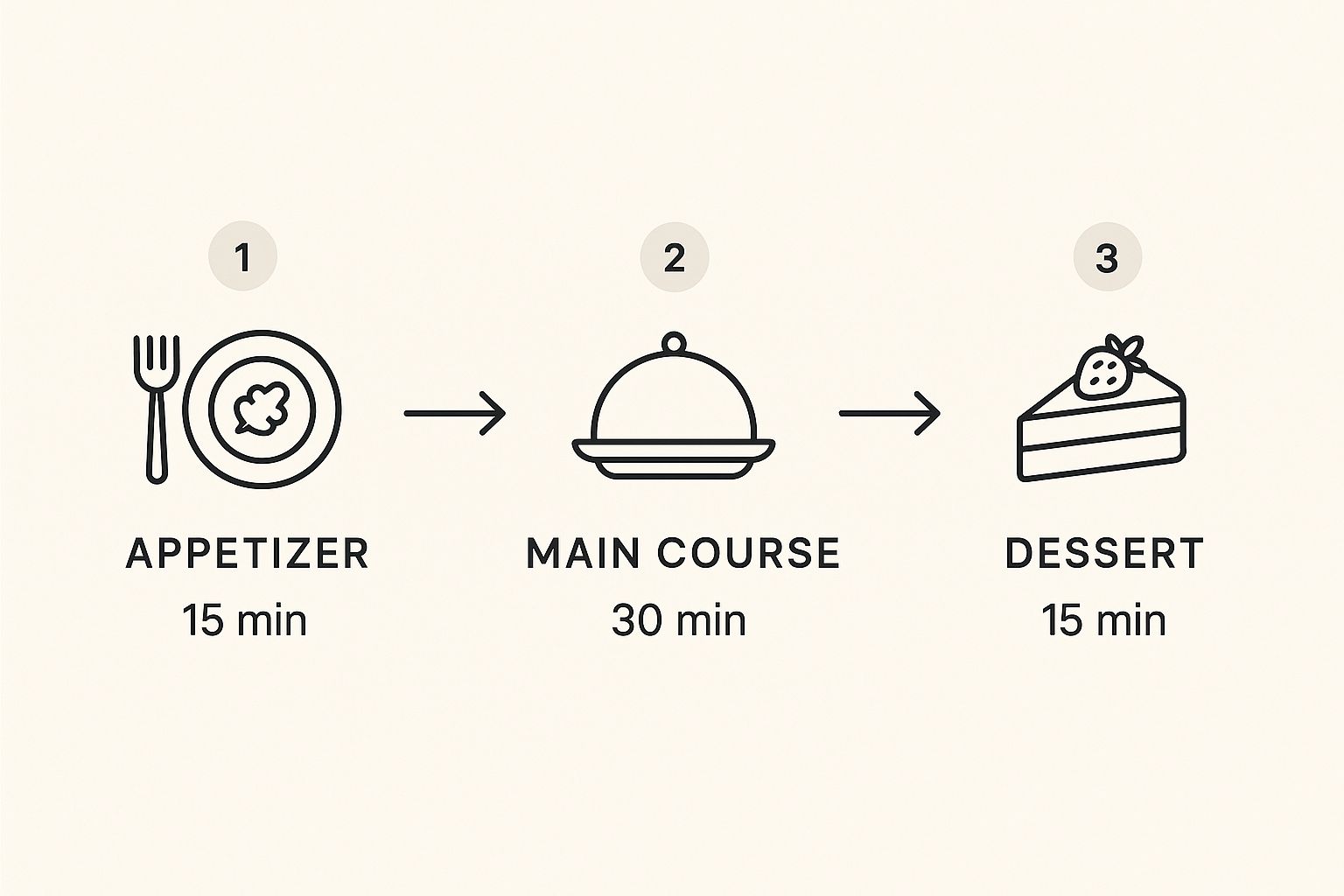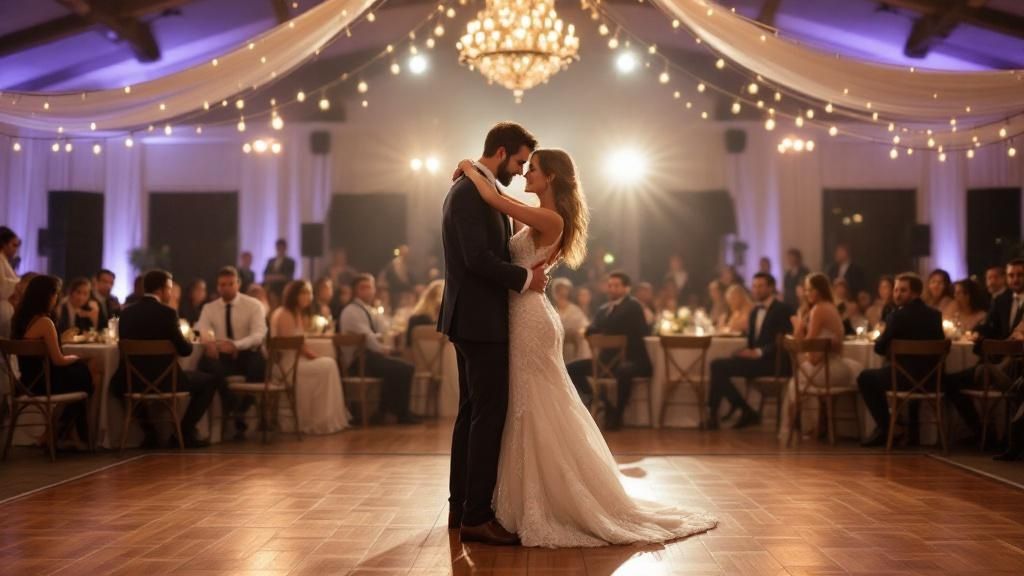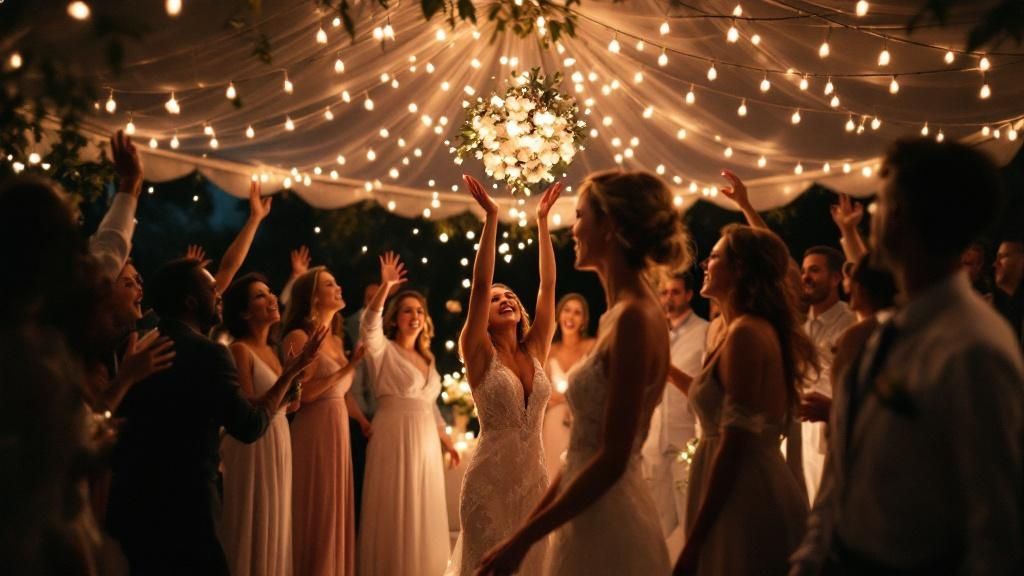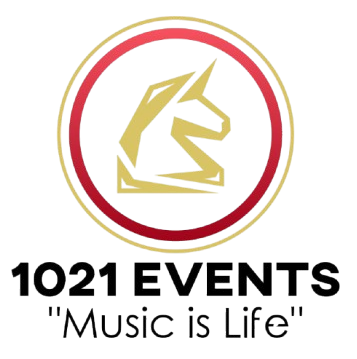Think of your wedding reception timeline as more than just a schedule. It’s the behind-the-scenes magic that makes sure every part of your party flows together, from the first toast to the last dance. This is the master blueprint that keeps your vendors on the same page, your guests happy, and the whole celebration feeling effortless.
Building the Blueprint for Your Reception Flow
Before you dive into picking out the perfect first dance song or deciding who gives a toast, you need to sketch out the basic structure of the evening. Don't think of it as a strict, minute-by-minute script. It’s more like a flexible roadmap that helps you build excitement and keep the good vibes going all night long.
Every great timeline is built around a few key moments that give the party its shape.
Anchor Your Schedule Around the Big Moments
The two biggest anchors for any reception timeline are your dinner service and your venue contract. These are the non-negotiables. Your caterer has a set plan for getting food out, whether it’s a plated meal, a buffet, or fun food stations. That schedule will take up a huge chunk of your evening and is usually the hardest thing to change.
At the same time, your venue contract tells you exactly when you can start and when you have to be out. These two things create the box you have to fit everything else into.
Pro Tip: My best advice? Don't fight your vendor timelines. Work with them. Use their schedules as the skeleton for your own and build all the other fun stuff around it. It saves a ton of stress and makes for a much smoother day.
Creating a Natural Rhythm
A killer reception tells a story. It has a beginning, a middle, and an end, and it all flows together to keep your guests hooked. You want to move them from one part of the night to the next without any awkward pauses or feeling rushed.
In the U.S., most receptions run about five or six hours—it's a sweet spot that feels just right for guests. We’ve seen from data collected by The Knot that 52% of couples are smart about using their timeline to build excitement, making moments like the cake cutting and first dance feel like major turning points.
For a quick look at how this all fits together, here’s a sample timeline for a standard 5-hour reception.
Standard 5-Hour Reception Timeline At A Glance
This table gives you a bird's-eye view of a classic reception flow. It’s a great starting point you can adjust to fit your own party's vibe and priorities.
| Time Slot | Event | Duration | Key Purpose |
|---|---|---|---|
| 6:00 – 7:00 PM | Cocktail Hour | 60 min | Mingle, drinks, and appetizers post-ceremony. |
| 7:00 – 7:15 PM | Grand Entrance | 15 min | Kick off the party and introduce the newlyweds. |
| 7:15 – 8:15 PM | Dinner & Toasts | 60 min | Main meal, heartfelt speeches, and guest mingling. |
| 8:15 – 8:30 PM | Special Dances | 15 min | First dance and parent dances. |
| 8:30 – 10:30 PM | Open Dance Floor | 120 min | The main party segment with music and dancing. |
| 10:30 – 11:00 PM | Cake & Send-Off | 30 min | Final traditions and a memorable exit. |
Remember, this is just a template! Your timeline will be unique to you, but seeing the basic structure helps make the planning process feel much less overwhelming.
Here’s a breakdown of how those pieces typically connect to create that perfect party atmosphere:
- The Transition: Cocktail hour is the perfect buffer. It gently moves everyone from the formal ceremony to a more relaxed, celebratory mood.
- The Kick-Off: The grand entrance is a jolt of pure energy. It officially announces, "The party starts now!"
- The Main Event: Dinner and toasts are the heart of the evening—a time for great food, conversation, and touching moments.
- The Party: Once that dance floor opens, the energy shifts into high gear. This is all about celebration and fun.
- The Grand Finale: The cake cutting, bouquet toss, and a grand send-off wrap everything up with a memorable finish.
Getting a handle on this basic flow is your first real step. To make it even easier, you can grab our complete wedding timeline template to help you map everything out from start to finish.
Mapping Out Your Timeline Hour By Hour
Okay, you've got the basic flow down. Now it's time to get granular and map everything out hour-by-hour. This is the secret to turning a general idea into a rock-solid plan that keeps your vendors in sync and the party vibes high all night long.
Let's break down each part of the night and plug in some realistic timings to make your reception feel completely seamless.
The Cocktail Hour and Grand Entrance
Think of the cocktail hour as your reception's opening act. It's usually about 60 minutes long, which is the sweet spot. This gives your guests enough time to grab a drink and start chatting after the ceremony, but it's not so long that they start getting antsy.
For you, this is prime time to finish up any remaining photos—especially couple's portraits if you didn't do a first look. Just try to stick to that one-hour mark. Any shorter feels rushed, and any longer, you risk losing the crowd's energy.
Then comes the Grand Entrance, the moment that officially kicks off the party. You only need about 10-15 minutes for this. Your DJ or MC will introduce your wedding party and then, with a ton of fanfare, present you as the newlyweds. It’s a fantastic way to grab everyone’s attention and set the tone for the rest of the night.
Dinner Service and Toasts
Dinner is the heart of the reception, and how you time it all comes down to the style of service you've chosen.
- Plated Dinners: These are pretty straightforward since your caterer will have a set schedule for bringing out each course. It's organized and efficient.
- Buffet Style: This gives guests more freedom, but you need to be the traffic cop. Have your DJ call tables up in small groups to prevent a massive line from forming.
Here’s a pro tip for toasts: schedule them between courses during a plated dinner. This is brilliant because your guests are already seated and attentive. It completely avoids that awkward moment of trying to get everyone to quiet down after they've already hit the dance floor. You could have a welcome toast right after your entrance, with the best man or maid of honor speeches happening between the starter and the main course.
This infographic gives a great visual for timing a three-course meal.

Seeing it laid out like this really shows how you can weave key moments like toasts into the natural breaks of the meal, keeping the whole evening flowing smoothly.
Kicking Off The Party
Your First Dance isn't just a sweet moment—it's a signal. Use it to officially open the dance floor. As soon as your song ends, have your DJ immediately invite all your guests to join you. This one simple move kills that awkward hesitation where nobody is sure if it’s time to dance yet.
Right after your dance, you can flow into parent dances (father-daughter, mother-son) or just open the floor for a solid 30-45 minutes of pure, high-energy dancing. It's the perfect way to get the party going before you dive back into any other formalities.
Your DJ is the quarterback of the reception. They aren't just playing songs; they're reading the room and directing the energy. Giving them a detailed timeline isn't micromanaging—it's setting them, and your party, up for success.
The Final Hour Traditions
The last 60-90 minutes of the night are for those final, memorable moments.
The Cake Cutting is a classic photo op, but it also serves a practical purpose. It subtly signals to older guests or those with kids that the main events are winding down, giving them a polite cue to head out if they're ready. This whole thing only takes about 5-10 minutes.
Once the cake is served, you can jump into other traditions like the bouquet and garter toss. After that, it's time for one last block of open dancing to close out the night strong.
Finally, the Grand Send-Off! This is your epic finale, so make sure to block out 15-20 minutes for it. You’ll need that time to get everyone lined up with their sparklers or bubbles. This buffer ensures your photographer can get that perfect, magical exit shot without anyone feeling rushed.
A detailed schedule ensures your DJ knows exactly when to make these announcements. To really nail this, we have a complete guide to building a wedding DJ timeline that makes sure every single one of these moments lands perfectly.
Making the Timeline Your Own

A standard timeline is a fantastic starting point, but let’s be honest—it’s just a skeleton. The real heart of your reception comes from weaving in the things that make you, well, you. This is your chance to transform a nice event into an unforgettable party that screams your names from the rooftops.
Think beyond just "cake cutting at 9 PM." It's about blending time-honored traditions with those quirky, personal touches that will have your guests saying, "That was so them!"
Weaving in Cultural and Family Traditions
For so many couples, honoring their heritage is a huge part of the day. Your reception timeline is the perfect canvas for this. Whether it's a high-energy Hora dance, a meaningful Chinese tea ceremony, or a lively money dance, these moments add a beautiful layer of richness to the celebration.
The trick is figuring out where they fit best. A vibrant tradition like the Hora is absolutely perfect for kicking off the open dance floor, getting everyone out of their seats and injecting a massive dose of energy right away. Something quieter and more intimate, like a tea ceremony, might feel more at home during cocktail hour or just before dinner service begins.
It's fascinating to see how these moments shape weddings globally. In India, receptions are often just one part of multi-day extravaganzas. Meanwhile, around 45% of French weddings stretch over several days with parties that go late into the night. It's a great reminder of how deeply traditions can influence the entire schedule.
Scheduling Unique Personal Moments
Beyond cultural traditions, you can sprinkle in personal events that show off your personalities. These are the unique wedding reception ideas that truly make your day stand out.
- A Surprise Choreographed Dance: Ditch the slow-and-steady first dance for a surprise routine with your wedding party. The best time to unleash this? Right after your grand entrance. It's a guaranteed way to get everyone hyped.
- The Shoe Game: This is always a hit with guests. It’s a hilarious game that works perfectly after dinner but before the dance floor officially opens up for the night. Think of it as the perfect, lighthearted transition.
- Anniversary Dance: This one’s a tear-jerker in the best way. Invite all married couples to the floor, then have the DJ slowly dismiss them by years married until only the longest-married couple remains. It’s a sweet moment to slot in right after the parent dances.
Pro Tip: Dying for those golden-hour sunset photos but don't want to kill the party vibe? The perfect window is while your guests are finishing their main course. They’re seated, fed, and happy—and won't even notice you’ve slipped away for 10-15 minutes.
At the end of the day, personalizing your timeline is about deciding what really matters to you both. Don't feel boxed in by what you're "supposed" to do. If you'd rather have an extra half-hour of dancing than do a bouquet toss, go for it! This is your celebration, and the schedule should feel like it.
Mastering the Vibe and Energy of Your Party
A great wedding reception timeline is so much more than a schedule. It's the invisible hand guiding the entire mood of your party, the secret script that dictates the energy from start to finish. Think about it: you want the vibe to flow seamlessly from an elegant dinner to an epic dance party without any of those awkward lulls. Pacing is everything.
One of the biggest mistakes I see couples make is clumping all the formalities together. If you cram the toasts, cake cutting, and special dances into one block, you’re practically begging for an energy crash. A much better approach is to sprinkle these moments throughout the evening. This keeps your guests engaged and wondering what’s coming next, instead of getting bored and checking their watches.
Guiding the Mood from Dinner to Dance Floor
That transition from a relaxed dinner to a high-energy dance party is probably the most crucial moment of the night. This is where your pros—especially your DJ or MC and your lighting team—really earn their keep. They work in tandem to shift the atmosphere in a way that feels completely natural.
For example, as dinner plates are being cleared, the music can slowly evolve from mellow background tunes to more upbeat, recognizable songs. It’s a subtle cue that things are about to kick off. At the same time, the lights can dim a bit, maybe with some dynamic effects coming into play. We actually have a whole guide on this, so be sure to check out our deep dive into the impact of professional wedding reception lighting.
Expert Insight: Please, don't underestimate the power of your MC. They are the voice of your timeline, the one who directs everyone's attention and announces each event without it feeling jarring. A great MC can fill any potential silence and build genuine excitement for what’s next, making the entire flow feel effortless.
How Long Should Key Events Really Be?
This is a question I get all the time. "How long should our first dance be? How long do people give speeches?" Keeping these moments concise is your secret weapon for maintaining momentum.
Here's my advice based on hundreds of weddings:
- Toasts and Speeches: Keep the whole block to 15-20 minutes, max. Ask each speaker to aim for 3-5 minutes. Even better? Split them up. Have one toast before dinner starts and maybe a couple more between courses. It’s so much more engaging than one long-winded speech marathon.
- Special Dances: For your first dance and any parent dances, about 2-3 minutes is the sweet spot. You can even ask your DJ to fade the song out early. This keeps the moment sweet and powerful without dragging on and losing your guests' attention.
- Cake Cutting: This is a quick photo op! The actual cutting of the cake only takes about 5 minutes. It’s a perfect little transitionary event that often signals that the final, party-hard phase of the evening is about to begin.
This balanced approach isn't just my opinion; it’s a global trend. The 2024 Global Wedding Report found that over 60% of couples are now intentionally planning their timelines to balance formal traditions with informal fun. In fact, dancing and entertainment often take up the biggest chunk of the reception—sometimes more than 40% of the entire event—which just goes to show that people everywhere want a real celebration. You can get more details in the full 2024 wedding report.
Ultimately, managing your party's vibe comes down to being thoughtful. By pacing your key events and using your pros to guide the mood with music and lighting, you’re not just following a schedule. You’re creating a dynamic, unforgettable experience that will have your guests captivated all night long.
How to Dodge Common Wedding Timeline Disasters

Even with a perfectly planned timeline, things can and do go sideways. Let's be real, life doesn't run on a minute-by-minute schedule. A truly great wedding reception timeline isn't just a list of events; it's a game plan for navigating the unexpected. Think of this as your chance to get ahead of the chaos and sidestep those common little hiccups that can sour an otherwise amazing day.
One of the biggest mistakes I see couples make? Underestimating how long everything takes. It sounds so basic, but it's the number one source of wedding day stress. From travel between the ceremony and reception to wrangling family for photos, everything just seems to expand to fill more time than you budgeted.
The Secret Weapon: Your Time Buffer
Here's the golden rule I tell all my clients: build a cushion into every single part of your schedule. Seriously. If you think family photos will take 30 minutes, schedule 45. If the drive is 20 minutes, block out 30.
This little bit of padding is your best friend. It’s what absorbs the small delays—a groomsman who can't find his tie, a toast that goes a little long—without sending the whole evening into a tailspin. It's the difference between feeling relaxed and feeling frantic.
Another classic timeline trap is not leaving enough time for photos. So many couples want those gorgeous, golden-hour portraits but forget that you actually need time for those moments to happen organically. If your ceremony wraps up right as the sun is setting, you’re in a mad dash against the dark, and that’s a recipe for stress, not dreamy photos.
Picture this: Your cocktail hour is set up beautifully on the lawn, and then a surprise rain shower hits. Without a backup plan, it's instant panic. But with a solid Plan B—like having an indoor space ready to go or even just a stockpile of chic umbrellas—a potential disaster becomes a funny story you'll tell for years.
Get Your Vendors on the Same Page
Your timeline is completely useless if it only exists in your head or on your phone. Your vendors—the photographer, caterer, and DJ especially—are a team. They need to be working from the exact same playbook. A shared, final timeline isn't a suggestion; it's an absolute must.
When everyone has the same document, magic happens:
- Your Caterer: Knows exactly when dinner needs to be served, hot and ready.
- Your Photographer: Is in position for the grand entrance and first dance, not stuck in the bathroom.
- Your DJ or MC: Can make announcements at just the right moment to guide your guests.
Getting your DJ looped in is huge, since they’re often the ones running the show and directing the flow of the entire reception. A great DJ can improvise and keep the energy up, but they can only do that effectively if they know the original plan. Using a detailed wedding DJ checklist is a fantastic way to ensure they have all the info they need to keep the party on track.
By thinking through these common pitfalls, you’re doing more than just making a schedule. You’re building a flexible, resilient plan that can handle whatever the day throws at you, leaving you free to actually enjoy it.
Your Top Wedding Reception Timeline Questions, Answered
Alright, let's get into the nitty-gritty. Building a timeline always brings up a few key questions. Once you get these figured out, you'll feel way more confident locking in the final schedule for your big day.
How Long Should a Wedding Reception Actually Be?
For most weddings, the sweet spot is somewhere between four and six hours. We find that a five-hour reception is the most common choice, and for good reason! It gives you just enough time for a cocktail hour, a relaxed dinner, all the key toasts, and plenty of dancing without feeling like a marathon.
But hey, this isn't a one-size-fits-all rule. The vibe of your wedding is what really matters. If you're planning a chill daytime brunch, three or four hours might feel just right. On the other hand, some cultural celebrations are known for going long into the night, and that’s part of the fun!
When Is the Best Time for Speeches and Toasts?
Here’s a pro tip that makes a huge difference: don't save all the speeches for one big block. It’s a guaranteed way to lose your guests' attention. A much better approach is to sprinkle them throughout the evening.
Try this: have a parent or even yourselves give a quick welcome toast right after the grand entrance. It's a great way to set the tone.
Then, slot in the Best Man and Maid of Honor speeches during dinner, right between the salad and main course. This is a genius move. Your guests are a captive audience, already seated and settled in. It completely avoids that post-dinner slump and keeps the energy up. Just give your speakers a heads-up to keep their toasts to a sweet and personal three to five minutes each.
Timeline Game-Changer: A 'first look' is more than just a sweet, private moment. It's a logistical lifesaver. By seeing each other before the ceremony, you can knock out most of your portraits early and actually get to attend your own cocktail hour.
How Does a First Look Shake Up the Timeline?
Choosing to do a "first look" is one of the single biggest things you can do to make your reception timeline flow better. It's an incredibly intimate moment for just the two of you, but the practical payoff is huge. You can get almost all of your formal photos—the ones with your wedding party and immediate family—done and dusted before a single guest even arrives.
Think about what that means for the rest of the day. Instead of disappearing for an hour after you say "I do," you get to walk right from your ceremony into your cocktail hour. You can mingle, grab a signature cocktail, and actually enjoy the party you planned. It creates a seamless, relaxed experience for everyone.
Do We Really Need to Follow the Timeline Exactly?
Think of your timeline as your trusted roadmap, not a strict, minute-by-minute itinerary. It’s absolutely essential for keeping your whole vendor team on the same page, but the most memorable events always have a little wiggle room.
A good timeline has buffer time built right in. Your coordinator or MC is a pro at making those small, on-the-fly adjustments that keep the party moving without anyone feeling rushed. Seriously, don't sweat it if you're running 10-15 minutes off schedule. It usually just means everyone is having an amazing time!
Ready to create a timeline that leads to an unforgettable party? The expert team at 1021 Events lives for this stuff. We specialize in crafting seamless, high-energy receptions with professional DJ/MCs, lighting, and photo booths that keep the celebration going all night long. See how we can make your day incredible at https://www.1021events.com.

